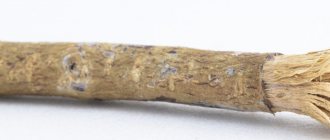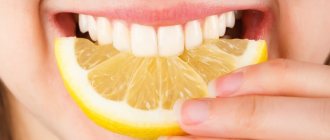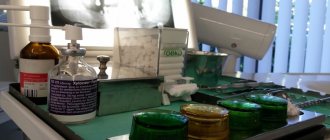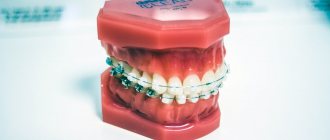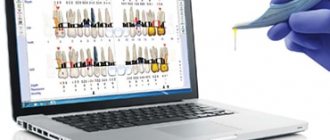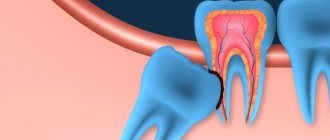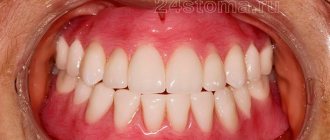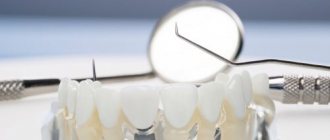Saint Antipas and granddaughter of Monomakh
The oldest, albeit dubious, dental recipes can be considered ancient Slavic conspiracies preserved in folklore. Here is an example of one of them: “You are a month, your silver horns, your golden legs. Come down, month, take away my dental grief. Take the pain under the clouds. Here’s a tooth, here’s two, here’s three – they’re all yours, take them...”
Conspiracies dating back to the depths of pagan times were supposed to be pronounced in a special way or in a special place. For example, in the case of a spell addressed to the month, it was necessary to pronounce this recitative, turning one’s face to the moon, so that its light would definitely fall on the sore teeth. A popular place for “treatment” of teeth in folk medicine was also a clearing with a large oak tree, next to which springs were sure to flow. Oak bark soaked overnight in the water of these springs was considered the best remedy for toothache. In a word, the imagination of such “recipes” is amazing, but we can hardly be amazed by their effectiveness.
The arrival of Christianity in Rus' left its mark on folk dentistry. To get rid of toothache, people were supposed to chew a blessed church candle or hang small silver teeth on icons. Even saints appeared, protecting and saving from toothache. These were considered either Saint Anthony or Saint Antipas. Records of “healing” prayers addressed to the latter have been preserved: “O glorious martyr Antipas, quick helper to Christians in illness! I believe with all my soul and thought that the Lord has given you the gift of healing the sick, healing the sick, and strengthening the paralytic. For this reason, to you, as a blessed doctor of diseases, I, the weak, come running and, kissing your venerable image with reverence, I pray - through your intercession from the Heavenly King, ask me, who is sick, for healing from the dental disease that depresses me...”
For most of our ancestors, such recipes and methods of treatment had no alternatives until the beginning of the last century. However, the first truly scientific work in the field of dentistry related to the history of our Fatherland appeared nine centuries ago. Historians are still arguing about the authorship of the Byzantine treatise “Ointments of Lady Zoya the Queen” - one of the old and generally accepted versions says that this manuscript was created through the efforts and by order of the granddaughter of the ancient Russian prince Vladimir Monomakh.
Dobrodeya Mstislavna, baptized Zoya, the daughter of a Novgorod prince and a Swedish princess born in Rus', in 1122 became the wife of the eldest son of the Byzantine emperor. It is she who is credited with the authorship of a medical treatise containing quite scientific methods for that era for the treatment of dental diseases and oral care. One of the recipes for “Zoya the Queen” reads: “For swaying teeth, take two drachms of castor beans, alum and pomegranate peels, grind and mix all this, rub the roots of the teeth; abstain from any very spicy food, from chewing almonds, walnuts and hazelnuts.”
The issues of dental aesthetics are not forgotten in the treatise of the 12th century: “In order to make your teeth white, take two drachms of burnt bran and white salt, grind it all well, rub your teeth...” Even if the skeptics are right and the granddaughter of Monomakh has nothing to do with the creation of this treatise, there is no doubt that the elite of Ancient Rus' took care of their teeth using similar methods and recipes.
To the Bader bathhouse
In the 18th century, medicinal baths, intended “for sweating and diluting gumboils,” tried to compete with ordinary baths. It is clear that specialized baths were visited only by representatives of the upper classes “on a doctor’s recommendation,” and the establishments were opened by foreigners. Thus, Leman’s Bader bathhouse, opened in 1760, was especially popular in St. Petersburg.
However, the medicinal baths did not last long. It’s understandable - what’s the point of narrow specialization if a Russian bathhouse cures all ailments, and public steam rooms offered a wide range of services, including tooth extraction.
In addition, in practice, it was probably found that at the initial stage of inflammation it is impossible to go to the bathhouse, so as not to get up the next day with a swollen gumboil, and even after removal it is advisable not to steam, so as not to increase blood flow, allowing the wound to heal faster.
Shock dentistry of Peter the Great
The “Domostroy”, famous in the history of Moscow Rus', is an “instruction” for all areas of home life that arose five centuries ago and also contains a number of recipes for dental treatment. For example, he advises chewing sauerkraut more often to strengthen gums. According to Domostroy, celery tincture is very good in dentistry - “rinse your mouth with the same tincture, it will remove the rotten smell from your mouth, strengthen your gums and cure toothache.” Crushed rose hips are also good - “Rub your gums and teeth with them, and that’s why the disease will go away.”
The first documentary mentions of professional dentists in Rus' also date back to the era of the first kings from the Romanov dynasty. In the archives of the Apothecary Order - a distant prototype of the Ministry of Health - for 1654, “tooth-pullers” are mentioned among various doctors, herbalists and chiropractors. This is the name given to specialists who treated “wormholes” in teeth and removed diseased teeth using “keys” and “pelicans” - special metal hooks, later in the Russian tradition called “goat legs”.
One of these “legs”, made by order of Peter I, is now kept in the Hermitage. This is the oldest dental instrument in Rus' that has survived to this day. Moreover, even teeth from Emperor Peter that were pulled out three centuries ago have been preserved for us. In the famous Kunstkamera, among other outlandish exhibits, there is a “Register of teeth pulled by Emperor Peter I” - a collection of 96 teeth personally removed by the reformer tsar in 1721–1724. All teeth are personalized, carefully signed. Among the king's patients there are all classes - from grooms and galley rowers to aristocrats. For example, there is a tooth of Princess Daria, the wife of Alexander Menshikov.
According to the memoirs of contemporaries, Tsar Peter was very interested in dentistry and, while in Holland, even took lessons from the best European dentists. The study was not in vain - in Peter’s dental registry of the Kunstkamera, molars predominate, i.e. The most inaccessible and difficult to remove are the back teeth. Despite the curvature of their roots, fractures and chips were not noted on most of the exhibits in the register, which clearly demonstrates the good preparation and dexterity of the crowned dentist. True, among the teeth removed by Peter I, along with the sick ones (familiar, alas, we all have pulpitis, caries, etc.), there are also quite healthy ones - the tsar used the “goat’s leg” deftly, but clearly did not bother himself with diagnostics.
Unlike Peter the Great, Empress Catherine the Great was interested in dentistry only as a patient - her memoirs are full of episodes describing dental problems: “My tooth hurt even more, and I was forced to go to bed. I began to have such a fever that I couldn’t remember myself... I lay in bed for ten or twelve days, and my toothache returned every day.”
Catherine II, the mistress of a vast empire, had access to the best medicine of that era, but, alas, in terms of dentistry, she, the elite of the elite, had to be content with only the simplest, even barbaric, in our opinion, treatment methods. In her memoirs, the queen describes her communication with Hermann Boerhaave, one of the best doctors of her time: “I asked him to pull out my tooth, which had been bothering me for four or five months. He did not agree, but I strongly insisted. Finally, he pulled out my tooth, but the minute he pulled, blood gushed out of my mouth... Along with the tooth, part of the gum was torn off. They put me to bed... I suffered a lot for more than four weeks.”
History of Russia, world history
“He who brushes his teeth in the morning acts wisely...”Since time immemorial, ancient people had to resort to various improvised means to remove food debris from their teeth. People didn’t brush their teeth with anything before the advent of toothpaste and brushes.
Humanity began to take care of oral hygiene a very, very long time ago. After examining the remains of teeth, which are more than 1.8 million years , archaeologists have determined that the small curved dimples on them are nothing more than the result of the influence of a primitive brush. True, she imagined just a bunch of grass with which ancient people rubbed their teeth. Over time, toothpicks became not just a hygiene item, but also an indicator of the status of their owner - in Ancient India, China, and Japan they were made of gold and bronze.
Also used for oral hygiene were ash, powdered stones, crushed glass, wool soaked in honey, charcoal, gypsum, plant roots, resin, cocoa grains, salt and many other components that were exotic to the eyes of modern man.
Mention of dental care and appropriate remedies is found already in written sources of Ancient Egypt . According to the testimony of ancient chroniclers, about five thousand years ago, the Egyptians achieved pearly white teeth using powder from dry incense, myrrh, kau, branches of the mastic tree, ram's horn and raisins.
In the Ebers papyrus, for oral hygiene, only rubbing teeth with onions is recommended, which made them white and shiny; one of the found manuscripts describes a recipe for a certain remedy, which included the following ingredients: ashes of the entrails of an ox, myrrh, ground eggshells and pumice, to Unfortunately, the method of using this remedy remains a mystery.
It was on the territory of Egypt that the first “civilized” toothbrushes appeared; the Egyptian ancestor of toothbrushes was a stick with a fan at one end and a pointed tip at the other. The sharp end was used to remove food fibers, the other was chewed with teeth, while coarse wood fibers removed plaque from the teeth. These “brushes” were made from special types of wood containing essential oils and known for their disinfecting properties.
They were used without any powders or pastes. Such “dental sticks”, about five thousand years old, are found in Egyptian tombs. By the way, in some corners of the Earth such “primitive brushes” are still used - for example, in Africa they are made from twigs of trees of the Salvadoran genus, and in some American states the indigenous population uses twigs of white elm.
Maintaining oral hygiene was important not only in Ancient Egypt; in India and the Chinese Empire, crushed shells, horns and hooves of animals, gypsum, as well as powdered minerals were used as cleansing compositions; wooden sticks were used, split at the ends in the form of a brush, metal toothpicks and tongue scrapers.
The first purpose-made gold toothpick was discovered in Sumer and dated to 3000 BC. e. An ancient Assyrian medical text described the procedure of cleaning teeth with the index finger wrapped in a cloth. Already in the second millennium BC. e. Tooth powder was used, made from pumice with the addition of natural acids - wine vinegar or tartaric acid.
The credit for further improvement of toothpaste itself belongs to two great civilizations in human history - the ancient Greeks and Romans, because it was the Mediterranean states that became the cradle of medicine.
Relatively regular oral hygiene practices have been known since Ancient Greece . Aristotle's student Theophrastus (died 287 BC) testified that the Greeks considered it a virtue to have white teeth and to brush them frequently. In the letters of the Greek philosopher Alciphron, who lived in the 2nd century BC. e., there is a mention of a hygiene product common at that time - a toothpick.
The first toothpaste recipes date back to 1500 BC. The famous healer Hippocrates (460-377 BC) made the first description of dental diseases and recommended the use of toothpastes. In the second millennium BC. e. already used tooth powder made from pumice with the addition of natural acids - wine vinegar or tartaric acid.
However, regular oral care did not become widespread until Greece became a province of Rome. Under Roman influence, the Greeks learned to use materials such as talc, pumice, gypsum, coral and corundum powder, and iron rust to clean teeth. Diocles of Karysto, an Athenian physician and contemporary of Aristotle, warned: “Every morning you should wipe your gums and teeth with bare fingers, then rub mint inside and outside your teeth to remove any remaining pieces of food.”
The ancient Aesculapians were the first to learn how to tie loose teeth together and hold artificial ones in place using gold wire. The first lead instrument for removing teeth was invented in ancient Rome Particular attention was paid to such aspects as fresh breath, to maintain which it was recommended to consume goat's milk. But the effectiveness of some of the recommendations for dental care, such as rubbing the ashes of burnt animal parts (mice, rabbits, wolves, bulls and goats) into the gums, rinsing teeth with turtle blood three times a year, wearing a wolf bone necklace as a dental talisman pain would raise great doubts today.
Hygiene in general and oral hygiene in particular occupied a significant place in the life of the Romans. Its necessity was defended by the Roman physician Celsius. A recipe has been preserved for removing and preventing the formation of “black spots on teeth”: brush your teeth with a mixture of crushed rose petals, tannins and myrrh, and then rinse your mouth with young wine.
Teeth cleaning powders with a large number of components were widely used. The bones, eggshells, and oyster shells that were included in their composition were burned, thoroughly crushed, and sometimes mixed with honey. The astringent components were myrrh and saltpeter, which simultaneously had a strengthening effect on the gums and teeth. The substance "nitrum" was mentioned - probably sodium or potassium carbonate. But most of the components were added to the powders for superstitious reasons or simply from the imagination of the manufacturer.
Guests invited to dinner were given not only spoons and knives, but also ornate metal toothpicks, often made of gold, which guests could even take home with them. A toothpick was to be used at every change of dishes. Among the ancient Greeks and Romans, toothpicks were made of wood, bronze, silver, gold, ivory and goose feathers in the form of thin sticks, often mounted together with an ear spoon and a nail pick.
The early Middle Ages brought the first evidence of professional cleaning of the oral cavity: the Greek Paul of Aegina (605-690) proposed removing tartar using a chisel or other tools. He also wrote about the need to maintain oral hygiene, in particular brushing teeth after eating, emphasizing that various foods stick to the teeth and leave plaque.
into the Arab world by the Prophet Mohammed (born in Mecca in 570 BC), introducing it into the Muslim religion. Among other requirements, the Koran requires rinsing the mouth three times before prayer (that is, 15 times a day). The Arabs cleaned their teeth according to the established ritual with the help of miswak - a stick made of fragrant wood with a split end like a brush and a chital toothpick - from the stem of an umbrella plant, and also from time to time they rubbed their teeth and gums with rose oil, myrrh, alum, and honey. The twig was soaked in clean water for about 24 hours until the fibers began to separate. The bark was removed, revealing a hard fiber that was quite flexible and easily split.
There are many more traditions related to oral hygiene associated with the Prophet Mohammed. For example, removing dental plaque in the interdental spaces, finger massage of the gums. Many of the rules of hygiene proposed by Mohammed exist in our time and are known from the works of the Muslim theologian of the last century, Ibn Abdin: “Teeth should be brushed with a natural brush if: 1) they have become yellow; 2) if the smell from your mouth has changed; 3) after you get out of bed; 4) before prayer; 5) before ablution."
Oral hygiene was also associated with religious beliefs among Hindus . The sacred book of the Veda contained a system of Indian medicine called the “science of life” (the materials presented in them date back to the first half of the 1st millennium).
Medical and religious beliefs proved to be an important reason for focusing Hindus' attention on their teeth. The mouth was seen as the gateway to the body, so it had to be kept absolutely clean. Brahmins (priests) brushed their teeth while watching the sunrise, while praying and calling on God to bless their families.
The ancient books called for proper behavior and daily routine, paying special attention to the cleanliness of the mouth and the need to remove plaque using a special tool with a flat, sharpened diamond tip.
Hindus considered the use of toothbrushes made from animal bristles to be barbaric. Their toothbrush was made from tree branches, the end of which was divided into fibers. The trees from which such rods were prepared were varied; it was only required that they be sharp in taste and have astringent properties.
The daily ritual was not limited to brushing teeth. After regular cleansing, the tongue was scraped out with a specially designed instrument, and the body was rubbed with aromatic oils. Finally, the mouth was rinsed with a mixture of herbs and leaves. More than two thousand years ago, Greek doctors were familiar with infusions of Indian herbs that eliminated bad breath. Even Hippocrates described a cleanser made from powdered anise, dill and miter mixed with white wine.
The history of the development of oral care products after the fall of the Roman Empire is almost unknown until 1000 AD. , it is from this period that oral care instructions found during excavations in Persia date back. These guidelines warned against the use of too harsh tooth powders and recommended the use of antler powder, crushed snail and clam shells, and calcined plaster. Other Persian recipes included compositions of various dried animal parts, herbs, honey, minerals, aromatic oil, etc.
, dental elixirs became fashionable in Europe
In 1363, the work of Guy de Chauliac (1300-1368) “The Beginnings of the Art of Surgical Medicine” appeared, which in 1592 was translated into French and was widely used by practicing doctors, becoming the main work on surgery of that time. The book focused on dentistry. The author divided dental treatment into two types: universal and individual. Guy de Chauliac considered, in particular, compliance with oral hygiene to be a universal treatment. The hygiene rules consisted of 6 points, one of which involved gentle brushing of teeth with a mixture of honey, burnt salt and a small amount of vinegar.
The greatest success fell to the tooth elixir of the Benedictine fathers. It was invented in 1373, but at the beginning of the twentieth century it was still sold in pharmacies.
Chauliac's successor Giovanni do Vigo (1460-1525), author of the treatise “Complete Practice in the Art of Surgery,” recognized that healthy teeth have a beneficial effect on a person’s mental and physical health. To prevent tooth decay, he prescribed mixtures of pomegranate, wild olive and other plants for rinsing, and recommended regular removal of tartar. The Italian doctor Chigovani Arcoli (d. 1484) widely promoted the 10 rules he described for dental care, including after meals. In the 15th century in England, barbers who also practiced surgery used various metal instruments and solutions based on nitric acid to remove tartar (it is worth noting that the use of nitric acid for these purposes was stopped only in the 18th century).
The first toothbrush like modern ones, made from pig bristles, appeared in China on June 28, 1497. What exactly did the Chinese invent? A compound brush , where pig bristles were attached to a bamboo stick.
The bristles were pulled from the scruff of pigs raised in northern China and even further north in Siberia. In cold climates, pigs have longer and stiffer bristles. Traders brought these brushes to Europe, but the bristles seemed too harsh to the Europeans. Those Europeans who had already brushed their teeth by this time (and there were few of them) preferred softer horsehair brushes. At times, however, other materials came into fashion, for example, badger hair.
Gradually, the Asian “new product” began to be “exported” to other countries of the world, and the fashion for brushing teeth reached Russia .
In Russia in the 16th century, similar “tooth brooms” were known, consisting of a wooden stick and a broom made of pork bristles - already under Ivan the Terrible, bearded boyars, no, no, and at the end of a stormy feast, from the pocket of their caftan, took out a “tooth broom” - a wooden stick with a tuft of bristles. These inventions were brought to Russia from Europe, where panicles made of horse hair, badger bristles, etc. were also used with pork whisks.
Toothbrushes were discovered during excavations in Novgorod. These are already full-fledged brushes with the bristles arranged like a modern brush, see the picture on the right.
Under Peter I, the royal decree ordered that the brush be replaced with a cloth and a pinch of crushed chalk. In the villages, teeth were still rubbed with birch charcoal, which perfectly whitened teeth.
Residents of the Japanese islands were introduced to a toothbrush and a tongue-cleaning twig by Buddhist priests, whose religion requires cleaning their teeth and tongue every morning before prayer.
The Japanese “Samurai Code” ordered all warriors to brush their teeth after eating with soaked twigs of bushes. During the Tokugawa (Edo) period (1603-1867), toothbrushes were made from willow twigs, separated into fine fibers and specially processed. The brushes were of a certain length and flat in shape, so that they could be used as a tongue scraper.
Toothbrushes for women were smaller and softer to preserve the black color of their teeth (women painting their teeth black was an ancient tradition). A polishing paste made from a mixture of earth and salt, scented with musk, was applied to the tip of the twig moistened with water.
Toothpicks, similar to modern ones, were made by hand in Japan and sold along with brushes and powders, which appeared on the market as early as 1634. Colorful display cases invited customers to special stores where all dental care items were sold. By the beginning of the 19th century, the number of such stores increased sharply. There were more than two hundred of them on the street leading to the main Edo temple alone.
In Europe, the toothbrush initially became an outcast : it was believed that using this tool was indecent (as we remember, ladies and gentlemen also did not consider washing something necessary). However, by the middle of the 17th century, the toothbrush began to gain ground, which was facilitated by an important event.
In 1530, the first book entirely devoted to dentistry was published in Leipzig . It was written in German, not Latin, and was addressed to barbers and surgeons.
The book was called “Small Medical Book on All Types of Dental Diseases and Infirmities” (Artzney Buchlein wider allerlei Krankeyten und Gebrechen der Tzeen).
It was based on the works of Galen, Avicenna and other Arab authors, consisted of 44 pages and over the next 45 years underwent more than 15 reprints. The book paid a lot of attention to oral hygiene. About 15 years later, surgeon Walter Ruff published the first monograph on dentistry for the layman, entitled “Helpful Tips on How to Keep Your Eyes and Vision Healthy and Maintained, with Further Instructions for Keeping Your Mouth Fresh, Teeth Clean, and Gums Firm.”
The famous 16th century surgeon Ambroise Paré recommended careful oral hygiene: remove all food debris from the teeth immediately after eating; it is necessary to remove tartar, as it acts on teeth like rust on iron; After removing stones from the teeth, the mouth should be rinsed with alcohol or a weak solution of nitric acid. To whiten teeth, weak solutions of nitric acid were most often used.
English sources of the 16th century describe various means for caring for the oral cavity; rubbing teeth with fingers and cloth and using toothpicks were widely recommended. Toothpicks were imported from France, Spain, Portugal, were considered very fashionable and were included in the list of items required for the queen. The respect for these hygiene items is evidenced by the reverent report that in 1570, Queen Elizabeth of England received six gold toothpicks as a gift.
Professional removal of dental plaque remained the job of barbers. Cintio d'Amato, in his book “New and Useful Methods for All Diligent Barbers,” published in 1632, Fr.
Advertising brochure for a dental office: the services of dentists were used in the 17th century
In the 17th century, Europeans enthusiastically brushed their teeth with salt, which was later replaced by chalk. The indescribable surprise of the Dutchman A. Leeuwenhoek (1632-1723), who designed the microscope, is known to have discovered microorganisms in the plaque on his own teeth, “despite the fact that they were regularly cleaned with salt.”
The first scientifically based presentation of material on oral hygiene belongs to Pierre Fauchard , who in his famous work “The Dentist Surgeon, or Treatise on Teeth” criticized the then prevailing opinion that the cause of dental diseases were some mysterious “tooth worms”. He identified 102 types of dental diseases and also developed a more humane method for removing teeth. The doctor also became famous for the fact that he invented false teeth, pin teeth, caps for teeth coated with porcelain enamel, and began to use primitive braces.
So, Fauchard argued that teeth must be brushed every day. True, in his opinion, horsehair, which was used in Europe to make bristles for toothbrushes, was too soft and could not clean teeth efficiently, and pig bristles, on the contrary, severely damaged the enamel of teeth. Alas, the doctor could not suggest any optimal material for bristles - his recommendations were limited to the instruction to wipe the teeth and gums with a natural sea sponge.
The first mention of toothbrushes in European literature dates back to 1675. It is believed that the first manufacturer of toothbrushes was the Addis company (1780) in London. She used natural bristles for these purposes. In 1840, brushes began to be produced in France and Germany.
Tooth powder , and then toothpaste , which are closest to modern ones, first appeared in the late 18th century in Great Britain. Although the powders were formulated by doctors and chemists, they often contained overly abrasive substances that could harm teeth: brick dust, crushed porcelain and clay shards, as well as soap. The dentifrice was sold in a ceramic container in two forms as a powder and a paste. People of good income had the opportunity to use a special brush to apply it, and those who were poorer did it with their fingers. The novelty did not arouse much enthusiasm, and soon in one of the magazines there appeared recommendations from experts not to use these powders, but to brush your teeth once every two weeks with a stick immersed in gunpowder.
In the 19th century, most dentifrices remained in powder form, sold in special small paper bags. Now its goal was not only to remove plaque, but also to at the same time give freshness to the breath, for which various natural additives were mainly used, such as strawberry extract. To make these products more palatable, glycerin was added to tooth powders.
In the 50s dentist John Harris suggested using chalk to make tooth powders, to which plant extracts or essential oils were added.
In Western Europe and Russia, chalk-based tooth powders were widely used. The first tooth powders were made in pharmacies according to special recipes, then their industrial production was established. The basis of these powders was chalk and magnesium carbonate. Finely ground leaves or fruits of medicinal plants (cinnamon, sage, violet, etc.) were added to the powders. Later, these additives were replaced by various essential oils.
In the second half of the 19th century, work began on the creation of toothpastes . The finest chalk powder was evenly distributed in the jelly-like mass. First, starch was used as a binder, from which a special paste was prepared in an aqueous solution of glycerin. Later, starch was replaced with a sodium salt of an organic acid, which stabilizes the chalk suspension. In 1873, Colgate introduced a flavored “liquefied” powder-paste in a glass jar to the American market, but consumers did not immediately accept the new product due to the inconvenience of packaging.
For some time, the so-called “tooth soap” was used for cleaning teeth, which consisted of kernel soap, chalk and fragrance (mint oil), thoroughly mixed together. Tooth soap was produced in the form of bars and plates of various shapes, packaged in paper or cardboard. It was convenient to use, but had an adverse effect on the gum tissue.
At the end of the 19th century, it became clear that tooth bristles needed a revolutionary new material when the outstanding French microbiologist Louis Pasteur hypothesized that microbes and viruses were the cause of many dental diseases. And where is it most comfortable for them to reproduce, if not in the moist environment of the natural bristles of toothbrushes? As an option, dentists suggested boiling toothbrushes daily, thereby disinfecting them, but this procedure quickly wore out the bristles and made the brush unusable.
In 1892, dentist Washington Sheffield invented the toothpaste tube . In 1894, a pump-fed tube was developed much like the ones we use today. In 1896, Mr. Colgate began producing toothpastes in tubes using his own technology, thanks to which both the tube and this paste received universal recognition in America and Europe, as they had not only higher hygiene and safety, but also undeniable household advantages: compactness and portability. With the introduction of packaging in a tube, toothpaste has become a basic necessity for people.
Since the end of the 19th century, the world began to switch to toothpastes in tubes . In most countries of the world, they came into use in the 30s of the 20th century and gradually began to replace tooth powders, since they had undeniable advantages - compactness, portability, plasticity, and better taste properties.
Before World War II, most toothpastes contained soap, although it was known to have many side effects. With the development of chemical technology, soap was gradually replaced by modern ingredients such as sodium lauryl sulfate and sodium ricinoleate.
Not only toothpastes, but also rinses became increasingly popular. They often contained chlorophyll to give a fresh green color. In 1915, extracts from certain trees growing in Southeast Asia, such as eucalyptus, began to be introduced into the composition of the products. “Natural” toothpastes containing mint, strawberry and other plant extracts are also used.
The development of technology has made it possible to significantly expand the spectrum of action of toothpaste. In addition to their main purpose - to clean teeth from plaque and freshen breath - they acquire therapeutic and preventive properties due to the inclusion of special additives. The first extended-release toothpaste appeared at the beginning of the 20th century. It contained a therapeutic and prophylactic additive - the enzyme pepsin, which, according to manufacturers, helped whiten teeth and dissolve plaque. The most important discovery of the 20th century in the field of oral hygiene can be considered the introduction of fluoride compounds into toothpastes, which help strengthen enamel.
In 1937, specialists from the American chemical company Du Pont invented nylon, a synthetic material whose appearance marked the beginning of a new era in the development of toothbrushes. The advantages of nylon over bristles or horsehair are obvious: it is lightweight, quite durable, elastic, moisture-resistant, and highly resistant to many chemicals.
Nylon bristles dried much faster, so bacteria did not multiply as quickly. True, nylon scratched gums and teeth quite a lot, but after some time Du Pont managed to fix this by synthesizing “soft” nylon, which dentists vied with each other to praise their patients.
The end of the 30s of the 20th century was marked by another important event in the world of oral hygiene - the first electric toothbrush . True, attempts to create such a device have been made for a long time. So, back at the end of the 19th century, a certain Dr. Scott (George A. Scott) invented an electric brush and even patented it in the American Patent Office. However, unlike modern devices, that brush “hit” a person with an electric current during use. According to the inventor, electricity could have a beneficial effect on dental health.
A more humane toothbrush, powered by an electric network, was created in 1939 in Switzerland, but production and sales began only in 1960, when the American pharmaceutical company Bristol-Myers Squibb released a toothbrush called Broxodent. It was planned that it would be used by people who have problems with fine motor skills, or those whose teeth are “decorated” with permanent orthopedic equipment (in other words, braces).
First experiences with using a motorized toothbrush... While your teeth are being brushed, you can shave...
In 1956, Proctor & Gamble introduced the first anti-caries fluoridated toothpaste, Crest with Fluoristat. But the improvement of paste recipes did not stop there. In the 70-80s, fluoridated toothpastes began to be enriched with soluble calcium salts, which strengthen dental tissue. And in 1987, the antibacterial component triclosan began to be included in toothpastes.
almost three-quarters of a century ; the first Soviet toothpaste in a tube was released only in 1950. Before this, pastes were sold in tin, and later in plastic jars. True, even in this package, toothpaste appeared on store shelves quite rarely; the undisputed leader in sales was tooth powder, which became so firmly established in the life of Soviet people that it penetrated into areas unusual for its intended purpose. In home economics books of the time, you will find tips on using tooth powder to clean windows, clean canvas shoes, or shine metal utensils. The powder went away following the fashion for canvas. Consumers enthusiastically accepted the new product - a foamy and fragrant toothpaste.
In 1961, General Electrics introduced its version of the electric toothbrush, designed for use by all people without exception. Unlike older models, this safer toothbrush did not work from the mains, but was powered by a built-in battery.
Over the next forty years, only the lazy did not try to experiment with a toothbrush. Experts say that between 1963 and 2000, more than 3,000 toothbrush models were patented. What they didn’t do with them: first the brush was equipped with a built-in timer, then it became possible to replace the cleaning heads, later electric rotating brushes were released, and then reciprocating rotating brushes. The bristles of the brushes began to be covered with a pigment that gradually wore off, which reminded the owner of the need to replace the brush. Then brushes with rounded ends of the bristles appeared, which were safer for teeth and gums.
The development of electric toothbrushes continues actively today. Before we had time to properly learn how to use them (these devices appeared in Russia 15 years ago), an electric toothbrush was invented, and a little later an ultrasonic brush appeared, which breaks chains of bacteria even 5 mm under the gum. Recently in Japan they introduced a brush that connects to a computer via a USB port. Time will tell where miracle technologies will take us tomorrow...
Well, the production of toothpaste these days is also a complex process, behind which there are numerous studies by scientists and the practical knowledge of dentists. The number of existing oral hygiene products and items is enormous and is steadily increasing every year.
So, if you regularly take care of your teeth, they will shine with beauty.
And it is ILLOGICAL to hide beautiful teeth.
Smile more often!
And now some advice from the “ancients” on caring for your teeth . Maybe it will be useful for someone...
- The most harmless procedure for getting rid of dental suffering was proposed 400 years ago by the German scientist Cardanus. He advised the patient to sit for several hours with his mouth open, turning towards the Moon: according to the medieval healer, the moon’s rays had a beneficial effect on a diseased tooth.
- And the famous scientist Pliny in the 1st century AD recommended putting crow or sparrow droppings mixed with oil in the ear on the side of the diseased tooth.
- In the 10th century, doctors used an enema and a laxative as the very first remedy for toothache. If there was no effect, the tooth was burned with a hot iron.
- Our great-grandfathers were convinced that a tooth begins to ache because a “tooth worm” settles in it and gnaws out a hole. They drove out the parasite not only with a hot iron, but also by pouring molten wax and acid into the hollow...
- Hippocrates in the 5th century BC recommended this remedy for preserving teeth and removing bad breath: “Burn the head of a hare and three mice... Grind the ashes together with marble in a mortar... Clean your teeth and gums with this powder, then wipe your teeth and mouth with sweaty sheep’s wool, smeared with honey.”
- Pliny advised eating a fried mouse once every two months as a preventive measure against caries.
- A simple recipe was given by the English medical monk John Gladdesden: a person should regularly breathe his own excrement.
- In China, it was considered right to brush your teeth with the ashes of a burnt monkey head.
- And the ancient Romans prepared powder from crushed pearls or corals for this hygienic procedure.
Written by Beowulf, edited by ddd
"Dentists" and "dental doctors"
Centuries ago, even unlimited power and countless money did not guarantee relief from toothache. Therefore, in the memoirs of the almighty Empress Catherine II, you will find many more episodes with dental problems and frightening details such as: “After several days of pain, four large teeth fell out, the two outer ones from each jaw...”
For the first time, the position of a dentist appeared on the staff of the Winter Palace at the direction of Tsar Alexander I in the first year of the 19th century. The future conqueror of Napoleon became acquainted with dentistry in his youth; at the age of 14, he had a molar removed. As one of the courtiers wrote about this: “Alexander Pavlovich, after suffering from toothache for a long time, decided to pull out the tooth, which was done successfully by the dentist. His Highness endured this action without uttering the slightest complaint, with a firmness of spirit pleased with his years, although he felt general pain, reasoning that the tooth was molar.”
Since then, Alexander I was very attentive to oral hygiene. Documents preserved in the archives show simply huge expenses for various dental elixirs and tooth powders for the tsar - more than 8 thousand rubles. annually, in that era, for this amount one could buy fifty serfs.
The first full-time dentist of the Russian tsars was the Frenchman Karl August Saucerot. France was then a world leader in dentistry, and a French dentist worked in the Winter Palace even at the height of the Napoleonic Wars. Since 1823, the Italian Giuseppe Fonzi, at that time probably the best dentist in the world, the inventor of the first porcelain dentures with metal pins, became the court dentist. Previously, the teeth of deceased people were usually used for dental prosthetics. Fortunately, the Napoleonic wars of the early 19th century. gave dentists a lot of similar material, which jokers of that era called “Austerlitz teeth.”
However, in the era of Pushkin, dental services were not always available even to the noble elite of society. Thus, in 1818, in St. Petersburg, whose population was approaching 400 thousand people, only 29 dentists worked. The apparent shortage of dentists led to the fact that on March 19, 1829, Tsar Nicholas I allowed women to take exams for the position of dentists. In other areas of medicine, women will not receive official recognition until half a century later. The first “dental doctor” to pass all required exams at the Imperial Medical-Surgical Academy was Warsaw resident Maria Nazon.
In the same 1829, the first fundamental textbook on dentistry was published in Russia - “Dentistry, or Dental Art on the Treatment of Dental Diseases.” Its author was the St. Petersburg doctor Alexey Sobolev, who began his medical career as a doctor in the Guards Engineer Battalion. In that era, the familiar term “dentist” was more often written with an “e”, like “dentist”.
East is a delicate matter. And not only him
Abul-Qasim, an Arab surgeon, made his debut in that part of the world by installing a prosthesis. He declared: dental prosthetics is medicine that allows you to cure or correct a defect in a person’s oral cavity. We are sure that it sounded different in Arabic.
In ancient times, in case of partial adentia, the tooth was mercilessly removed - this was the only alternative method of treatment. Doubtful, but still. Replacing a jaw is the prerogative of exclusively wealthy people, and by our standards, using very dubious methods.
Until the 18th century, dentures were placed in the oral cavity on a special wire made of gold or silver. Artificial teeth are made from animal bones, sometimes cattle.
The example of a prosthetic leg worn by one of the political figures is quite frightening. George Washington, the very first President of the United States of America, used a rather unusual design. Hippopotamus bone as a base for a prosthesis on which eight teeth were located. According to sources, they were human.
The President of the United States and presumably his dentures
